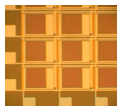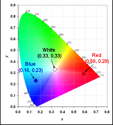
White Light-Emitting Devices on Flexible Plastic Substrate
Hojin Lee, Aaron R. Johnson, and Jerzy Kanicki
 Today polymer light-emitting devices (PLEDs) emerge as very promising candidate for the flexible flat panel displays since they can be easily fabricated over large-area flexible substrate at low temperature and low cost. Especially, the white light-emitting devices are drawing special attention as possible candidate for both solid-state lighting and full color display applications. In this project, we developed different color PLEDs on the flexible plastic substrate with the bottom-light emission structure. The schematic device cross-section and top-view are shown in the figures. An Al/Ca bi-layer and ITO were used as cathode and anode electrode, respectively. The PEDOT:PSS deposited on the pre-patterned ITO layer was used as the hole injection layer (HIL). On the top of the HIL, the polymer blend was deposited by spin coating method as the light emissive layer (LEL). The poly (fluorene) based blue and red light-emitting co-polymers were used to prepare the blend. Our typical dimension of complete PLED was 1.1 × 1.1 mm2. Today polymer light-emitting devices (PLEDs) emerge as very promising candidate for the flexible flat panel displays since they can be easily fabricated over large-area flexible substrate at low temperature and low cost. Especially, the white light-emitting devices are drawing special attention as possible candidate for both solid-state lighting and full color display applications. In this project, we developed different color PLEDs on the flexible plastic substrate with the bottom-light emission structure. The schematic device cross-section and top-view are shown in the figures. An Al/Ca bi-layer and ITO were used as cathode and anode electrode, respectively. The PEDOT:PSS deposited on the pre-patterned ITO layer was used as the hole injection layer (HIL). On the top of the HIL, the polymer blend was deposited by spin coating method as the light emissive layer (LEL). The poly (fluorene) based blue and red light-emitting co-polymers were used to prepare the blend. Our typical dimension of complete PLED was 1.1 × 1.1 mm2.
 Without the optimized device structure and fabrication processes, we have achieved the maximum luminance of ~7400 cd/m2, turn on voltage of ~5.6 V, and maximum emission-efficiency of 2.0 cd/A in the nitrogen atmosphere. We have also investigated the dependence of PLED CIE color chromaticity on polymer blend composition. By the appropriate selection of polymer blend constituents, the efficient energy transfer between host and guest polymer can be achieved and broad light emission spectrum can be made to generate white light. With the highly controlled blending ratio of blue (host) and red (guest) polymer, the PLED CIE coordinate from our device is (0.33, 0.33), which corresponds to a pure white color. The goal of this Without the optimized device structure and fabrication processes, we have achieved the maximum luminance of ~7400 cd/m2, turn on voltage of ~5.6 V, and maximum emission-efficiency of 2.0 cd/A in the nitrogen atmosphere. We have also investigated the dependence of PLED CIE color chromaticity on polymer blend composition. By the appropriate selection of polymer blend constituents, the efficient energy transfer between host and guest polymer can be achieved and broad light emission spectrum can be made to generate white light. With the highly controlled blending ratio of blue (host) and red (guest) polymer, the PLED CIE coordinate from our device is (0.33, 0.33), which corresponds to a pure white color. The goal of this  project is to have better understandings about the energy transfer process and to optimize the device structure and organic materials to achieve the highest possible white light-emission at low voltages or/and current densities. Long-term goals include the development of the flexible active-matrix full color display and the white solid-state light sources based on this technology. project is to have better understandings about the energy transfer process and to optimize the device structure and organic materials to achieve the highest possible white light-emission at low voltages or/and current densities. Long-term goals include the development of the flexible active-matrix full color display and the white solid-state light sources based on this technology.
H. Lee, A. R. Johnson, and J. Kanicki, “White light-emitting device based on polyfluorene co-polymers blend on plastic substrate,” IEEE Trans. Electron Devices, Vol. 53, no. 3, pp. 427-434, 2006.
top
|

